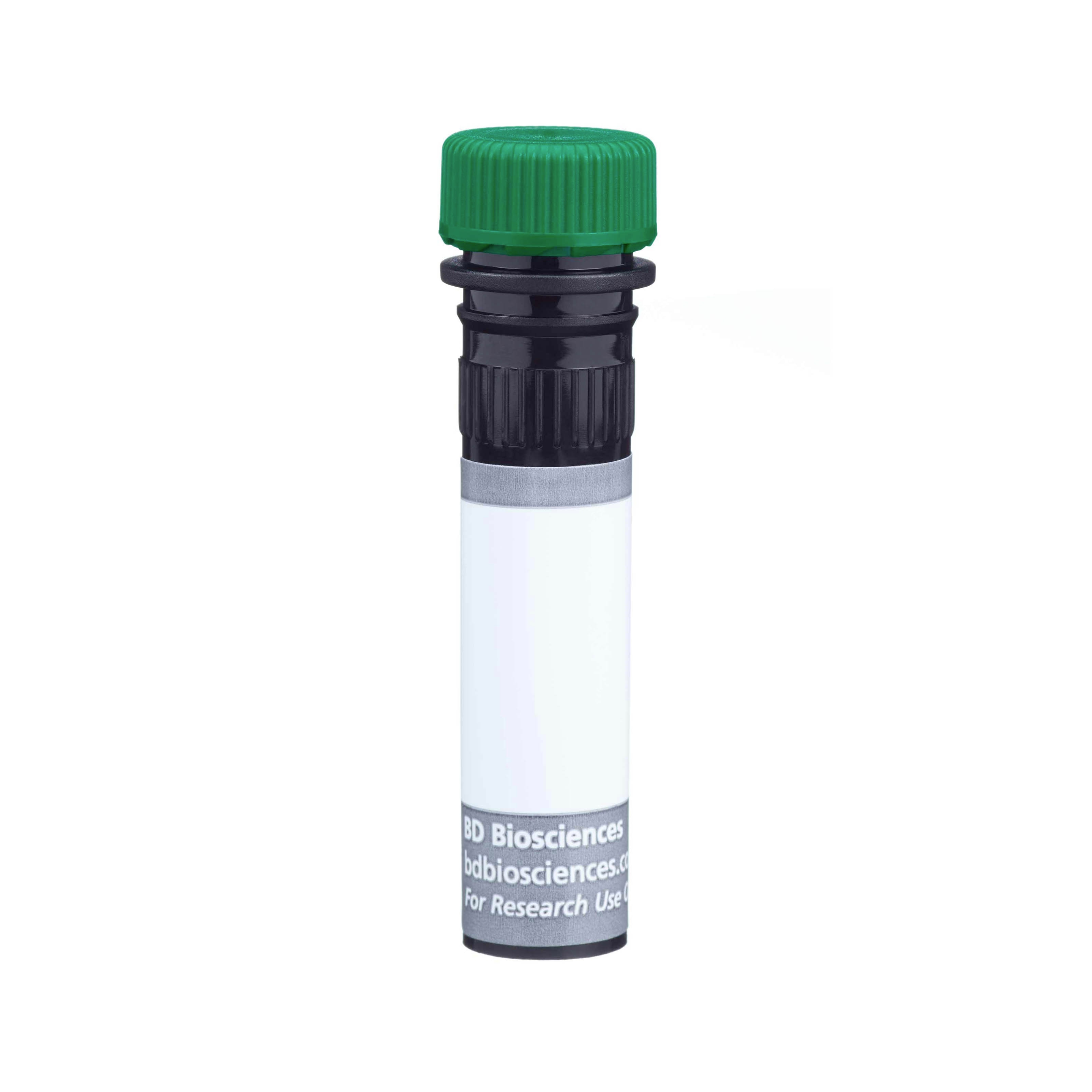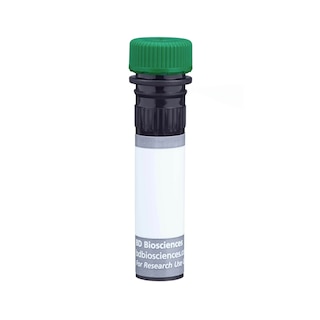Old Browser
Looks like you're visiting us from {countryName}.
Would you like to stay on the current country site or be switched to your country?


Regulatory Status Legend
Any use of products other than the permitted use without the express written authorization of Becton, Dickinson and Company is strictly prohibited.
Preparation And Storage
Recommended Assay Procedures
For optimal and reproducible results, BD Horizon Brilliant Stain Buffer should be used anytime two or more BD Horizon Brilliant dyes (including BD OptiBuild Brilliant reagents) are used in the same experiment. Fluorescent dye interactions may cause staining artifacts which may affect data interpretation. The BD Horizon Brilliant Stain Buffer was designed to minimize these interactions. More information can be found in the Technical Data Sheet of the BD Horizon Brilliant Stain Buffer (Cat. No. 563794).
Product Notices
- This antibody was developed for use in flow cytometry.
- The production process underwent stringent testing and validation to assure that it generates a high-quality conjugate with consistent performance and specific binding activity. However, verification testing has not been performed on all conjugate lots.
- Researchers should determine the optimal concentration of this reagent for their individual applications.
- An isotype control should be used at the same concentration as the antibody of interest.
- Caution: Sodium azide yields highly toxic hydrazoic acid under acidic conditions. Dilute azide compounds in running water before discarding to avoid accumulation of potentially explosive deposits in plumbing.
- For fluorochrome spectra and suitable instrument settings, please refer to our Multicolor Flow Cytometry web page at www.bdbiosciences.com/colors.
- Please refer to www.bdbiosciences.com/us/s/resources for technical protocols.
- BD Horizon Brilliant Stain Buffer is covered by one or more of the following US patents: 8,110,673; 8,158,444; 8,575,303; 8,354,239.
Companion Products






The DTA-1 monoclonal antibody specifically binds to GITR [Glucocorticoid-induced Tumor necrosis factor (TNF) receptor family-Related], a 66-70-kDa homodimer glycoprotein that is a member of the TNF receptor superfamily and is also known as TNFRSF18 and CD357. As its name implies, GITR expression was first detected in T lymphocytes that had been treated with dexamethasone, a glucocorticoid. In normal naive mice, GITR is expressed at moderate levels on CD25-positive/CD4-positive/CD8a-negative thymocytes and on CD25-positive/CD4-positive/CD45RB-low splenocytes. It is also expressed at low levels on splenic CD25-negative/CD4-positive/CD45RB-low T lymphocytes, B lymphocytes, macrophages, and dendritic cells. Activation of T and B lymphocytes upregulates GITR expression. GITR is a costimulatory receptor that plays an important role in Regulatory T (Treg)-cell functions, and a GITR Ligand has been detected on B lymphocytes, macrophages, and dendritic cells. mAb DTA-1 abrogates suppression by Treg cells without affecting their proliferative response, while it is co-stimulatory for T lymphocytes that are not Treg cells.
The antibody was conjugated to BD Horizon™ BUV563 which is part of the BD Horizon Brilliant™ Ultraviolet family of dyes. This dye is a tandem fluorochrome of BD Horizon BUV395 which has an Ex Max of 348 nm and an acceptor dye. The tandem has an Em Max at 563 nm. BD Horizon BUV563 can be excited by the 355 nm ultraviolet laser. On instruments with a 561 nm Yellow-Green laser, the recommended bandpass filter is 585/15 nm with a 535 nm long pass to minimize laser light leakage. When BD Horizon BUV563 is used with an instrument that does not have a 561 nm laser, a 560/40 nm filter with a 535 nm long pass may be more optimal. Due to the excitation and emission characteristics of the acceptor dye, there may be spillover into the PE and PE-CF594 detectors. However, the spillover can be corrected through compensation as with any other dye combination.

Development References (9)
-
Beilharz MW, Sammels LM, Paun A, et al. Timed ablation of regulatory CD4-positive T cells can prevent murine AIDS progression. J Immunol. 2004; 172:4917-4925. (Biology). View Reference
-
Dittmer U, He H, Messer RJ, et al. Functional impairment of CD8-positive T cells by regulatory T cells during persistent retroviral infection. Immunity. 2004; 20:293-303. (Clone-specific: In vivo exacerbation). View Reference
-
Ji H, Liao G, Faubion WA, et al. The natural ligand for glucocorticoid-induced TNF receptor-related protein abrogates regulatory T cell suppression. J Immunol. 2004; 172:5823-5827. (Biology). View Reference
-
Kohm AP, Williams JS, Miller SD. Ligation of the glucocorticoid-induced TNF receptor enhances autoreactive CD4-positive T cell activation and experimental autoimmune encephalomyelitis. J Immunol. 2004; 172:4686-4690. (Clone-specific: Flow cytometry, In vivo exacerbation). View Reference
-
Nocentini G, Giunchi L, Ronchetti S, et al. A new member of the tumor necrosis factor/nerve growth factor receptor family inhibits T cell receptor-induced apoptosis. Proc Natl Acad Sci U S A. 1997; 94:6216-6221. (Biology). View Reference
-
Shimizu J, Moriizumi E. CD4-positive CD25-negative T cells in aged mice are hyporesponsive and exihibit suppressive activity. J Immunol. 2003; 170:1675-1682. (Clone-specific: Functional assay). View Reference
-
Shimizu J, Yamazaki S, Takahashi T, Ishida Y, Sakaguchi S. Stimulation of CD25-positive CD4-positive regulatory T cells through GITR breaks immunological self-tolerance. Nat Immunol. 2002; 3(2):135-142. (Immunogen: Cell separation, Depletion, Flow cytometry, Functional assay, Immunoprecipitation, Inhibition, In vivo exacerbation). View Reference
-
Tone M, Tone Y, Adams E, et al. Mouse glucocorticoid-induced tumor necrosis factor receptor ligand is costimulatory for T cells. Proc Natl Acad Sci U S A. 2003; 100(25):15059-15064. (Biology). View Reference
-
Uraushihara K, Kanai T, Ko K, et al. Regulation of murine inflammatory bowel disease by CD25-positive and CD25negative CD4-positive glucocorticoid-induced TNF receptor family-related gene-positive regulatory T cells. J Immunol. 2003; 171:708-716. (Clone-specific: Cell separation, Flow cytometry, In vivo exacerbation). View Reference
Please refer to Support Documents for Quality Certificates
Global - Refer to manufacturer's instructions for use and related User Manuals and Technical data sheets before using this products as described
Comparisons, where applicable, are made against older BD Technology, manual methods or are general performance claims. Comparisons are not made against non-BD technologies, unless otherwise noted.
For Research Use Only. Not for use in diagnostic or therapeutic procedures.
Report a Site Issue
This form is intended to help us improve our website experience. For other support, please visit our Contact Us page.